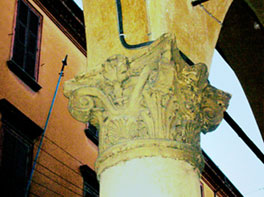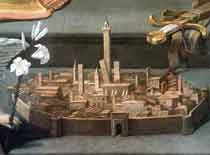|
BED AND BREAKFAST IN BOLOGNA ACCOMMODATION IN BOLOGNA ERBORISTERIA WEBMASTER |
||||||
|
|
Soon after the year 1000 Bologna was among the first
Lombard cities to become a Commune. Then it joined the "Lombard League"
against Fredrick Barbarossa. It was the focal point of Byzantine, Roman
and Lombard influence and an important trunk road; tolls had to be paid on
all goods passing through to the South. The aristocratic families, the
owners of the land, lived inside the town and always built the towers
within the "selenite circle" for defence and prestige. In
town the first groups of the middle-class were forming, together with the
founding of the first University in Europe; its needs -
resulting from the inrush of students - brought about first the
addition of boroughs and later the final enlargement of the town within
the circle of the
"Torresotti" (UnderTowers). From the top of the
Asinelli towers you can see very well: the layout of the town with
its streets which are still inserted in the geometrical urban network of
the Roman town and open radially towards the countryside (a particularly
useful structure, because a network of concentric streets crossing the
radial ones enables to follow the shortest ways in town). In the 12th
Century during struggle between Bologna and Floren-. |
Bologna in a particular of Guido Reni's La Pietà dei mendicanti |
b u |
|||
|
General - Environment - Iron and Etruscan Age - Roman Age - Patron Saint- The Commune - Alma mater studiorum - Re Enzo - Porticoes - St Peter - Gothic - 14th Century - Piazza Maggiore - Aristocratic palaces - Brick and other stones - Early 15th Century - Archiginnasio - Counter Reformation Renaissance - 16th Century - Great portico ribbons - Frescoes in palaces - The "scenographic" city - Napoleon's republics - Fall of Church power - The Restoration - Haussmann style - The new Century - Floreal style - Rationalism - World War - Active preservation - Around 2000 |
||||||

